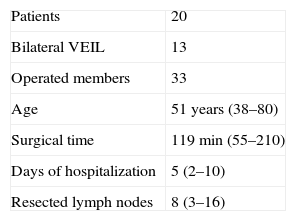We evaluated the reproducibility of video endoscopic inguinal lymphadenectomy (VEIL) and we report our initial experience in the treatment of penile cancer with palpable inguinal lymph nodes.
Materials and methodsFrom July 2006 to November 2010 were conducted 33 VEIL in 20 patients as complementary treatment for penile cancer in two referral hospitals in Latin America. We analyzed the epidemiological and clinical characteristics of patients and surgical and oncologic outcomes.
ResultsFifty-five percent of the patients included were clinical stage N0 and 45% were N+. Thirteen patients underwent bilateral VEIL and the remaining seven underwent VEIL unilateral and conventional open surgery in the contralateral limb. The average operative time for VEIL was 119min and mean resected lymph nodes was 8 per lymphadenectomy. The overall complication rate was 33.2%. No patient had skin necrosis. The lymphatic complication rate was 27.2%. Of the 6 cases in which the saphenous vein was preserved (18.2%) there were no lymphatic complications (p=.2). The overall survival rate was 80% and cancer-specific survival was 90%. Mean follow-up was 20 months.
ConclusionsVEIL in the adjunctive treatment of penile cancer is safe, reproducible and may be an alternative to conventional lymphadenectomy. Patients with palpable lymphadenopathy also may benefit from this technique. Oncological results seem to be adequate however require longer follow-up to be confirmed.
Evaluamos la reproducibilidad de la linfadenectomía inguinal vídeo endoscópica (VEIL) y relatamos nuestra experiencia inicial en el tratamiento del cáncer de pene con ganglios palpables.
Material y métodosDe julio de 2006 a noviembre de 2010 fueron realizadas 33 linfadenectomías inguinales vídeo endoscópicas en 20 pacientes, como tratamiento complementario del cáncer de pene, en 2 hospitales de referencia en Latinoamérica. Fueron analizadas las características epidemiológicas y clínicas de los pacientes, así como los resultados quirúrgicos y oncológicos.
ResultadosDe los pacientes incluidos el 55% fueron de estadio clínico N0 y el 45% fueron N+. La VEIL se llevó a cabo de forma bilateral en 13 pacientes y en 7 casos se realizó VEIL unilateral, asociada con la cirugía convencional contralateral. El tiempo operatorio medio de la VEIL fue de 119min, y la media de adenopatías resecadas fue de 8 por cada linfadenectomía. La tasa global de complicaciones fue del 33,2%. Ningún paciente presentó necrosis cutánea. La tasa de complicaciones linfáticas fue del 27,2%. En los 6 casos en que se preservó la vena safena interna (18,2%) no hubo complicaciones linfáticas (p=0,2). La tasa de sobrevida global fue del 80% y la sobrevida cáncer específica fue del 90%. El seguimiento medio fue de 20 meses.
ConclusionesLa VEIL en el tratamiento complementario del cáncer de pene es un procedimiento seguro y reproducible, siendo una alternativa a la linfadenectomía convencional. Los pacientes con adenopatías palpables también se pueden beneficiar con esta técnica. Los resultados oncológicos son adecuados, aunque se necesita más tiempo de seguimiento.












